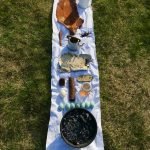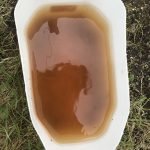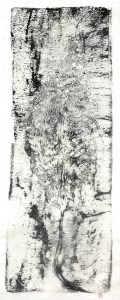A collection of artefacts come about from my artist-in-residency on Hysvær, a beautiful archipelago in the UNESCO World Heritage site outside Vega in North Norway organised by Kunstslipp and Randsone Vega.
There, I had the unique opportunity to engulf myself in the world of seaweed. That also entailed the perpetual sound of eider ducks and hundreds of other, amazing and outspoken birds filling the blissfully, quiet air with their multitude of chats, songs and calls.
 Inspired by the Japanese for for seaweed, Mo, I dived into this, sometimes slimy but enticing, universe. The Mo sign is formed of three, fused components; plants, water and three mouths suggesting the chirping of many small birds in the treetop. The characters together can be interpreted as plants buffeted by the water under the waves in gentle, cleansing motions, accompanied by the birds above.
Inspired by the Japanese for for seaweed, Mo, I dived into this, sometimes slimy but enticing, universe. The Mo sign is formed of three, fused components; plants, water and three mouths suggesting the chirping of many small birds in the treetop. The characters together can be interpreted as plants buffeted by the water under the waves in gentle, cleansing motions, accompanied by the birds above.
I arrived to the island of Brattøya with a bundle of tools, some old sheets from a retirement home and two books as my guidelines: Vegetables from the Sea by Seibin & Teruko Arasaki and Eco Colour by India Flint. I had no preconceived ideas but an open mind and an urge to make, experiment and become familiar and friendly with the rooted and flowing creatures of this underwatery wonderworld. For a week I touched, smelt, felt, ingested, fermented and eventually became entangled, internally and externally, in the world of seaweed. Inspired by ancient, Japanese, dying traditions I soaked my torn up sheets and bathed them in alternating baths of eggwater and lyme made from the ash of burning seaweed. Interchanging proteins and alkaline. I added my own urine to some. I embedded seaweed onto the infused sheets and rolled them up into bundles that I tied up tightly with string, once used in the boatbuilding workshop on the quay. Some of the bundles I boiled and dried. Another I dug into a fermenting pond of sulphurous seaweed on the shore and gave it a 21 days gestation time, as long as it takes for the eider ducks to hatch their eggs into ducklings. I also made seaweed paper out of the semi fermented weeds, ingested lightly cooked and delicious kelp spaghetti and pickled different kinds of weeds – some more palatable than others. The seaweed ash I also mixed with Gum Arabic and turned into writing ink and gin, water and rice flour made into printing ink for this exhibition. And I found some new and delightful friends, scattered around the shores. Small, character full and funky.
FUSED
Sheets,
once imprinted by
wrinkled skin
Residue of dreams,
now impressed by underwater bodies
Patterns from other worlds
Enrolled and etched
Fused and unravelled
Recycled sheets from a retirement home, bathed in alternate alkaline and protein baths. Rolled into tight bundles with seaweed and twine with some found bits of rusty iron bars, aluminium or copper, here and there. Sown onto willow sticks.
Aahoo – Hoho
Soundscape of seascape with recorded sounds from Hysværet.
Including eider ducks, oystercatchers, common snipes, curlews and seagulls.
And a traditional down harp and an interior well for rain water collection.
Sound technician: Nathanaël Gustin
Mo-Mo-Mo
Three gel-prints portraits of kelp and seaweed on hand made Japanese washi paper. Printed with handmade ink made from seaweed ash, nori rice paste and gin.
Hohoo – hohoo
A collection of creatures with hair styled by underwater forces.
These are photos from the residency stay at Hysvær hosted by Vibeke Steinsholm, Kunstslipp.














































